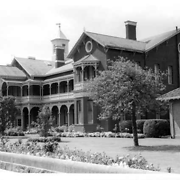
Ballarat Orphanage, c. 1963 - c. 1965, by John T. Collins, courtesy of State Library of Victoria.
Details
Ballarat Orphanage was the new name given in 1909 to the former Ballarat District Orphan Asylum. It accommodated boys and girls from around Victoria, aged between 4 and 16. In 1968, the name changed to Ballarat Children's Home.
The Ballarat Orphanage was a large, two-storey Gothic-style building, dating back to 1865. In his submission to 'Forgotten Australians', Frank Golding tells of his first reactions to the imposing buildings:
I snatched at each shaft of the iron fence as the policeman pulled us towards the great double gate. The gravel crunched under our feet as we drew near the dark-red building. Looking up to the balcony on the second floor, Billy read to us the cast iron words 'ORPHAN ASYLUM 1865'. This was a grim place, this Ballarat Orphanage. Solid, like a fortress.
An article published in the Argus newspaper demonstrates how the Orphanage represented itself to the Victorian public:
It is the claim of the orphanage committee that the orphanage has one of the widest and also one of the narrowest doors in the world. No child of good character is refused admission, no matter what may be his creed and nationality. That is the width of the door. And this is the narrowness of it - the child must be absolutely destitute. But it happens that there are few Ballarat children so hopelessly placed that there is none to look after them: therefore, if the hospitality of the orphanage was confined to Ballarat, about nine-tenths of its spacious buildings would stand silent and empty. But this hospitality is wide enough to embrace the whole state, and so the place is fairly full - there are 179 inmates - though there is still room for more.
The children were housed in separate sections of the Orphanage, depending on their age and sex. There were areas for toddlers (known as 'the bubs'), girls and boys. This system meant that siblings admitted to the Orphanage were most likely separated. Alan Radcliffe, who was admitted to the Orphanage with his siblings in the 1930s, describes how children lived at Ballarat:
I was placed into the toddler's section, my sister Elsie went to the girl's section and Syd was placed into the boy's section. The Ballarat orphanage was a very big home, which had about 470 boys and girls in it. As a two-year-old older girls who were in the home looked me after. As I got older I they was placed into the boy's section. The home had a big farm a very big garden and their own school.
Frank Golding was separated from his brother Bill, but lived alongside his brother Bob, as they were close in age. In his submission to the 'Forgotten Australians' inquiry, he wrote:
With scores of children to play with, over time the idea of brothers and sisters became irrelevant. Many children with shared surnames had no other bond. Some children told us they had brothers or sisters in other orphanages. In our case although we looked like peas in a pod, especially Bob and me, we did not act like 'normal' brothers except when one of us was being picked on and a fraternal instinct could be relied on. We were thrust together with hordes of other children and some became almost as close friends as brothers.
The children of Ballarat Orphanage attended an on-site school. The children's work in the farm, laundry, dairy, gardens, kitchen, boot-repair and woodwork workshops were seen by the Orphanage as 'valuable education' for the inmates. Photographs in the Argus in 1924 depict the boys in the 'sloyd class' (woodwork) with the caption 'The system of education adapts boys to go on the land and if a farmer is a good carpenter that will be of great assistance to him. The boys also learn to repair their own boots.' A photograph of the girls has the caption: 'All the girls shown in this photograph will, by the time they leave the orphanage, be good, plain cooks, they will be able to make their own dresses, and will understand all about the laundry'.
From 1920, children at the Ballarat Orphanage spent time at a beachside holidays in Queenscliff. The first holidays at Queenscliff saw the girls sleeping in the Church of England Hall and the boys in tents lent by the military authorities. This 'change of air' was so successful that the Orphanage committee arranged for the Queenscliff Rest Home to become a branch of the Orphanage, and dormitories for the children were built on its grounds for annual holidays.
The Superintendent of Ballarat Orphanage during this period was Arthur Kenny. He first began work at the institution when it was known as the Ballarat District Orphan Asylum. Kenny began as a gardener, but was made Superintendent in 1884. His obituary in the Ballarat Courier stated that due to his natural talent for handling children and especially boys, 'the first opportunity that arose saw him placed in the more responsible position, with the late Mrs Kenny as Matron'.
Kenny was apparently known as 'the Mister' by the children in the orphanage. He died in 1925, after 50 years as Superintendent. He was succeeded by H.C. (Bert) Ludbrook.
Mrs Kenny retired as Matron in 1921, but continued as 'Lady Superintendent' until her death in 1924. Her daughter, Sister Lulu Kenny, took over as Matron, remaining in the role for 35 years. Another daughter of the Kennys, Jean, was the Assistant Secretary of the Orphanage.
During World War Two, the Rest Home was taken over by the military.
In Frank Golding's memoir An orphan's escape (2005) which describes his experiences as a resident of Ballarat Orphanage in the 1940s and 1950s, he remembered the trips to Queenscliff with fondness:
After Christmas we went to the Orphanage's Queenscliff Rest Home in Stevens Street for two precious weeks. Parole in paradise. Singing every mile, we travelled by slow train to Geelong, and the rest of the way by bus … Every day the Orpho children walked to the back beach, with miles of clean, hot sand to sunbake on and heavy waves for body surfing … We loved going to Queeny for all sorts of reasons but perhaps the best was that we dressed like normal children on holidays. We had runners, singlets and shorts, not at all like the daggy outfit the institution made us wear in Ballarat (pp.85-87).
In the 1960s, the Orphanage began to organise summer camps at Queenscliff, the boys and girls holidaying separately.
The institution finally sold the house at Queenscliff in 1973.
The article in the Argus from 1924 described mealtimes at the Orphanage: '… these youngsters sit down to decently prepared tables, white cloths spread and polished knives and forks; and to a meal of pudding, soup and vegetables, good substantial and ample.'
The journalist's depiction of the food is a stark contrast to one written by Frank Golding in his submission:
The best that could be said about the food was that it was regular and recurrently basic. Bread and dripping ('flop') was our common breakfast with a mug of lukewarm tea. The main meals were routinised: you could tell what day of the week it was by what we were eating. The menu was totally predictable. And there was never enough.
In his submission, Alan Radcliffe remembered the rituals of mealtimes at Ballarat Orphanage:
When it was time for breakfast dinner or tea the boys would line up single file the girls would come in a different section we would march single file into the dining room and stand at our allotted place around the table. The superintendent and other man were in the dining room. We all stood to say a prayer before we sat down. If it were not loud enough the supervisor would bang the table and say 'Not loud enough, say it again'. Following this prayer the two of supervisors would march up and down the isle. If any girl or boy talked they would render a wack on their back.
The collection of the CLAN Orphanage Museum includes original menus from the Ballarat Orphanage from the 1960s.
After World War Two, the Board of Management decided to move towards the 'cottage' system of accommodation. This project did not commence in earnest until the mid 1950s, when the Orphanage began negotiations and planning with the Hospitals and Charities Commission. Rebuilding began in 1959.
On 14 February 1960, staff and children were transferred from the old building to a new services block, which included an assembly hall, kitchen, dining rooms, sewing rooms, laundry and boiler-house.
The east wing was demolished to make way for a residence for 54 boys and 3 housemasters. This new residence, which opened in 1961, could house children in a cottage system, comprising three potentially independent units.
In 1963, work began on another residential unit for 40 children. The Albert W. Leech Cottage (named after an 'old boy' who had died in the war) opened in February 1964. It accommodated 20 boys and 20 girls.
In 1965, the Orphanage announced its plans to build an extra wing of the Albert W. Leech Cottage for 20 more children, a new unit for senior girls and an administration building.
The Ballarat Orphanage accommodated a large number of Aboriginal or Koorie children, many of them having been removed from their families in western Victoria.
The importance of the institution to Indigenous people is recognised by the former site of the Orphanage's inclusion on the Ballarat Koorie Heritage Trail (there is an interpretation board at Damascus College, 150 metres from the corner of Stawell and Victoria Streets).
Murray Harrison (a Wotjabaluk man originally from Dimboola) and two of his sisters were removed from their family at Bruthen in Gippsland, and sent initially to the 'depot' at Royal Park. Harrison has positive memories of the Ballarat Orphanage, particularly compared with his time at Turana in Royal Park, and being in a home with other Indigenous children:
Coming here, to actually see the black faces of the children here, that was something [I heard my sisters] say, 'I think we're home.' For us, to see people who really are us - whether they were direct family or another tribal people, we were still of the same personage and blood…
The Orphanage commissioned a history to celebrate its centenary in 1965. Its author, Miss Ethel Morris, reflected on the changes that had taken place over 100 years:
Gone are the buildings the founders fought so hard to achieve, replaced by a village-like pattern of attractive cottage units … And the children of 1965 … These children of the new century know all about what goes on in their fast-moving world as they watch television and listen to the radio in their recreation rooms, and browse through the books in their well-equipped libraries … Best of all, they 'belong', in smaller groups under the care of house 'mothers' and 'fathers'.
The prospect of a name change for the Orphanage was first mooted in the early 1960s by its then-president, Dr CE Richardson. According to the Morris history, Dr Richardson 'took the view that as few of the children in the home were orphans, and most came from broken homes, the word "orphanage" was no longer applicable'.
In 1968, the Ballarat Orphanage ceased to be. The new name of the organisation was Ballarat Children's Home.
1865 - 1909 Ballarat District Orphan Asylum
1909 - 1968 Ballarat Orphanage
1968 - 1984 Ballarat Children's Home
1984 - 1998 Ballarat Children's Homes and Family Services
1998 - Child and Family Services Ballarat
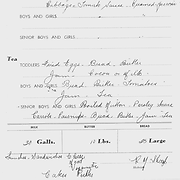
![A muster of the children [editor's note: Ballarat Orphanage]](../objects/thumbs/tn_D00000294 muster Balalrat Orphanage.png)
![The Sloyd Room [editor's note: Ballarat Orphanage]](../objects/thumbs/tn_D00000293 sloyd Ballarat Orphanage.png)
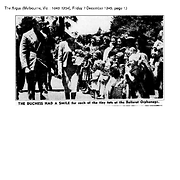
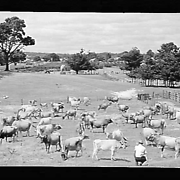
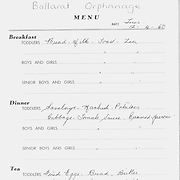
Sources used to compile this entry: Transformation by industry. Ballarat Orphanage. The site once a desert., The Argus, 12 January 1924, 8 pp, http://nla.gov.au/nla.news-article1938466; Death of Mr A. Kenny: "father" of orphanage passes, The Ballarat Courier, 30 September 1925; 'From Bruthen to Ballarat: Murray Harrison', in ABC Ballarat, 13 February 2008, http://www.abc.net.au/local/stories/2008/02/13/2161178.htm; Victoria Government Gazette Online Archive 1836-1997, State Library of Victoria, 2009, http://gazette.slv.vic.gov.au/; Golding, Frank, An Orphan's Escape: memories of a lost childhood, Lothian Books, South Melbourne, 2005. pp.85-87.; Morris, Miss Ethel, A Century of Child Care: the story of Ballarat Orphanage, 1865-1965, Ballarat Orphanage, c.1965; 'Submission no 18', in Inquiry into Children in Institutional Care: Submissions received by the committee as at 17/3/05, http://www.aph.gov.au/Parliamentary_Business/Committees/Senate/Community_Affairs/Completed_inquiries/2004-07/inst_care/submissions/sublist; 'Submission no 515', in Inquiry into Children in Institutional Care: Submissions received by the committee as at 17/3/05, http://www.aph.gov.au/Parliamentary_Business/Committees/Senate/Community_Affairs/Completed_inquiries/2004-07/inst_care/submissions/sublist.
Prepared by: Cate O'Neill
Created: 13 February 2009, Last modified: 19 June 2019